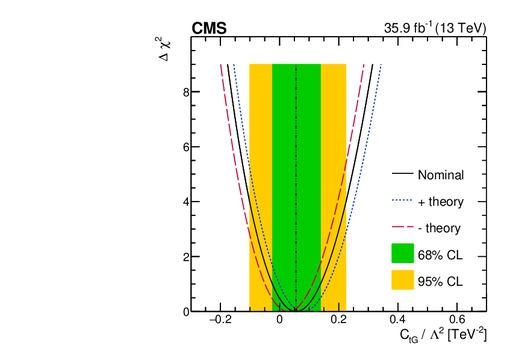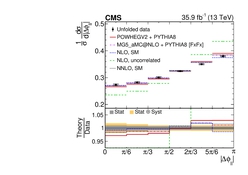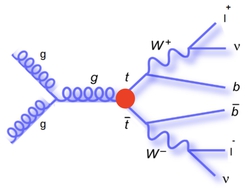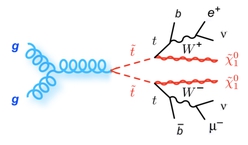BSM Searches with Top Quarks
High Precision Top Quark Measurements and Searches for SUSY and other New Physics
Compact Muon Solenoid Experiment
High Precision Top Quark Measurements and Searches for SUSY and other New Physics
Top Quark Pair Production Cross Section at 13 TeV
Shortly after the start of Run 2 of the Large Hadron Collider (LHC) at CERN (Geneva, Switzerland) in June 2015, scientists from the EXO group at DESY and their colleagues from the CMS experiment have performed a first important test of the Standard Model of particle physics. Using data from proton-proton collisions at higher proton beam energies than ever achieved before, we looked at the production rate of pairs of top quarks in final states with two leptons. An example graph is shown in Figure 1.

Figure 1: CMS proton-proton collision event of a candidate for top quark pair production in a dilepton final state (left), and example Feynman graph of this process (right).
We wanted to find out if the cross section behaves differently at higher collision energies and maybe show a glimpse of new physics already. However, our study showed: it didn’t [1]. The top quark pair production cross section in ppbar and pp collisions as a function of the centre-of-mass energy is shown in Figure 2. Our new result is represented by the red data point and is in agreement with the Standard Model prediction (black curve with green band).
Top Quark Pair Production Cross Section at 13.6 TeV
We did it again: Together with the CMS DESY Top-Quark-Group, we performed the first measurement of the top quark pair production cross section in proton-proton collisions also at √s= 13.6 TeV. The data for this analysis was recorded with the CMS detector at the CERN LHC only in Summer 2022, and corresponds to an integrated luminosity of 1.21 fb−1. Events are selected with one or two charged leptons (electrons or muons) and additional jets. A maximum likelihood fit is performed in event categories defined by the number and flavors of the leptons, the number of jets, and the number of jets identified as originating from b quarks.
However, also at the new world record collision energy, the cross section behaves exactly as expected by the Standard Model with no indication for new physics at the new energy frontier [2]. The top quark pair production cross section in ppbar and pp collisions as a function of the centre-of-mass energy is shown in Figure 3, now including our newest result represented by the red data point which is in agreement with the Standard Model prediction (black curve with green band).

Figure 3: Top quark pair production cross section as function of centre-of-mass energy, including our measurement at world record energy of 13.6 TeV
Top Quark Pair Spin Correlation and Top Quark Polarisation
The spin of the top quark can be inferred from the particles it decays to. The SM makes precise predictions for the frequency that the spin of the top quark is aligned versus opposed to the spin of the top antiquark. A measure of the correlation of the top quark and antiquark spins is a highly sensitive test of the SM. If, for example, an exotic heavy Higgs boson would exist, it could decay into a pair of top quarks and antiquarks and change their spin correlation significantly. The high precision measurement of the spin correlation opens a window to explore physics beyond our current knowledge.
Our group studied all spin and polarisation effects accessible in ttbar production by measuring different observables sensitive to spin correlation and to the top quark polarisation, and comparing them to high-precision theory predictions [3]. Figure 4a (left) shows the azimuthal opening angle between two leptons. It can be seen that one of the Monte Carlo simulations (POWHEGv2+PYTHIA8) shows a moderate discrepancy to the data. This is also in accordance with an observation made by the ATLAS Collaboration [3]. The NLO SM calculation, however, shows better agreement. In all other observables studied in this analysis good agreement between data and theory predictions is found. As an example, a measurement sensitive to the top quark polarisation is presented in Fig. 4b (right) showing no angular dependence, as expected for unpolarised top quarks.
In general, a good agreement to the SM prediction is observed in CMS data.
Today:
The full Run-2 data set already recorded by CMS contains four million ttbar pairs. This will allow even more precise measurements, increasing the chances for a first glimpse of new physics. The DESY Exotics group is currently performing such measurements with the full Run-2 data.
Search for Effective Field Theory (EFT) Couplings
We also use our measurements of the top-antitop quark spin correlation and the top quark polarisation to perform a powerful search for new physics in production and decay via an Effective Field Theory (EFT) approach [3]. Figure 5 shows a possible Feynman graph involving, as an example, the EFT coupling CtG due to an anomalous chromomagnetic dipole moment. Such a coupling would modify spin correlation and polarisation in top quark pair production compared to the SM process shown in Fig. 1. The result for the EFT coupling CtG is consistent with Zero, as shown in Fig. 6, and therefore consistent with the Standard Model. All investigated anomalous couplings are in agreement with the Standard Model, and improve on previous limits.

Figure 6: The Δχ2 values from the fit to the data as a function of the EFT coupling CtG. The solid line is the result of the nominal fit, and the dotted and dashed lines show the most-positive and most-negative shifts in the best fit CtG, respectively, when the theoretical inputs are allowed to vary within their uncertainties. The vertical line denotes the best fit value from the nominal fit, and the inner and outer areas indicate the 68 and 95% CL, respectively.
Today:
We are currently extending the search for EFT couplings in the top quark sector using the full Run-2 data set (2016-2018 data).
Search for Top Squark Pair Production
We intend to study a specific model that predicts zero spin correlation, i.e. a search for supersymmetric (SUSY) top squark pair production.
At the Large Hadron Collider (LHC), the SUSY partners of the top quark, the top squarks, could be produced in pairs. Models with light top squarks are particularly attractive since they provide a solution to the hierarchy problem. In such models, the mass m~t1 of the lighter top squark mass eigenstate ~t1 could be close to the mass of the top quark m_t. If the lightest SUSY particle, the neutralino χ~^0_1 (or alternatively the gravitino), is light and the top squark mass is only slightly larger than the top quark mass, two-body decays ~t → t χ~0 in which the momentum of χ~0 is very small can predominate. If the masses of all other SUSY particles are assumed to be large, in SUSY models where R parity is conserved, such as the minimal supersymmetric standard model (MSSM), this could lead to
t ̄t χ~ 0 χ~ 0 intermediate states. An example graph is shown in Figure 7. Such a process would appear to look like SM t ̄t production with additional missing transverse momentum carried away by the escaping neutralinos, making traditional searches exploiting kinematic differences very difficult. Therfore the model is called the "stealth top squark" scenario. However, such scalar top quark pair events can be distinguished from SM t ̄t events through an increase of the measured t ̄t cross section, and since top squarks have zero spin, through measuring angular correlations sensitive to spin correlation.
We intend therefore to re-interpret our measurement of the top quark pair spin correlation to search for top squark pair production in this "stealth top squark" scenario.
We would look for a PhD student as part of a doctoral thesis, or an advanced master student to perform this analysis. Feasibility studies can be done by bachelor students.
Future:
We also plan to do the search for top squark pair production in the stealth scenario as part of the full Run-2 data set (2016-2018 data) ttbar spin correlation measurement.
References:
[1] CMS Collaboration, Measurement of the top quark pair production cross section in proton-proton collisions at √s = 13 TeV, Phys. Rev. Lett. 116, 052002 (2016), arXiv:1510.05302 [hep-ex], CMS-TOP-15-003.
[2] CMS Collaboration, First measurement of the top quark pair production cross section in proton-proton collisions at √s = 13.6 TeV, HEP 08, 204 (2023), arXiv:2303.10680 [hep-ex], CMS-PAS-TOP-22-012.
[3] CMS Collaboration, Measurement of the top quark polarization and ttbar spin correlations in dilepton final states at √s=13 TeV, Phys. Rev. D 100, 072002 (2019), arXiv:1907.03729 [hep-ex], CMS-TOP-18-006.




